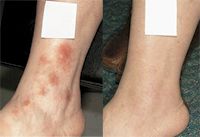- Acne
- Actinic Keratosis
- Aesthetics
- Alopecia
- Atopic Dermatitis
- Buy-and-Bill
- COVID-19
- Case-Based Roundtable
- Chronic Hand Eczema
- Chronic Spontaneous Urticaria
- Drug Watch
- Eczema
- General Dermatology
- Hidradenitis Suppurativa
- Melasma
- NP and PA
- Pediatric Dermatology
- Pigmentary Disorders
- Practice Management
- Precision Medicine and Biologics
- Prurigo Nodularis
- Psoriasis
- Psoriatic Arthritis
- Rare Disease
- Rosacea
- Skin Cancer
- Vitiligo
- Wound Care
Article
Trial reveals benefits of excimer laser on early-stage mycosis fungoides
New Orleans — Mycosis fungoides (MF), the most common form of cutaneous T-cell lymphoma, has been most commonly treated in its early stages with skin-directed therapies such as topical corticosteroids, nitrogen mustard, UVB, PUVA and total skin electron beam irradiation. More recently, dermatologists have begun using narrow-band UVB with a spectrum peak of 311 nm as an alternative treatment for early-stage MF.


Therapeutic trial "We conducted a therapeutic trial of the laser for the treatment of early stage cutaneous T-cell lymphoma, or MF," Dr. Upjohn says. "We recruited eight patients with MF, all of whom had been treated with previous therapies including PUVA topical steroids, topical nitrogen mustard and radiotherapy."
"Of the eight participants recruited, one withdrew for reasons unrelated to his MF and one had only a partial response," he says. "The others were judged to have a complete clinical and histological response and tolerated therapy well."
Dr. Upjohn says follow-up continued on the subject patients, and that to date, none have relapsed in their treated areas. He adds, however, that one patient developed further disease in non-treated areas and has commenced PUVA treatment.
"We believe that an advantage of the 308 nm excimer laser treatment is that therapy is quick, well-tolerated and spares unaffected skin, reducing the total UV exposure patients receive," Dr. Upjohn says. "As the cumulative dose of UV received by a patient can be a limiting factor when prescribing phototherapy, the use of 'focal' UV, such as that delivered by the 308 nm laser, may well prolong the clinical usefulness of this modality for what is a chronic dermatologic condition. Being able to apply the laser focally is a big advantage; if the disease recurs, which it's likely to, we can treat it again."
Dr. Upjohn says that as far as patient preference is concerned, these particular patients often preferred the twice-weekly laser treatments to daily application of creams, and compared the laser treatment favorably to traditional UV modalities.
Dr. Upjohn emphasizes, however, that treatment with the 308 nm excimer laser is not appropriate for more advanced forms of MF.
Newsletter
Like what you’re reading? Subscribe to Dermatology Times for weekly updates on therapies, innovations, and real-world practice tips.
















